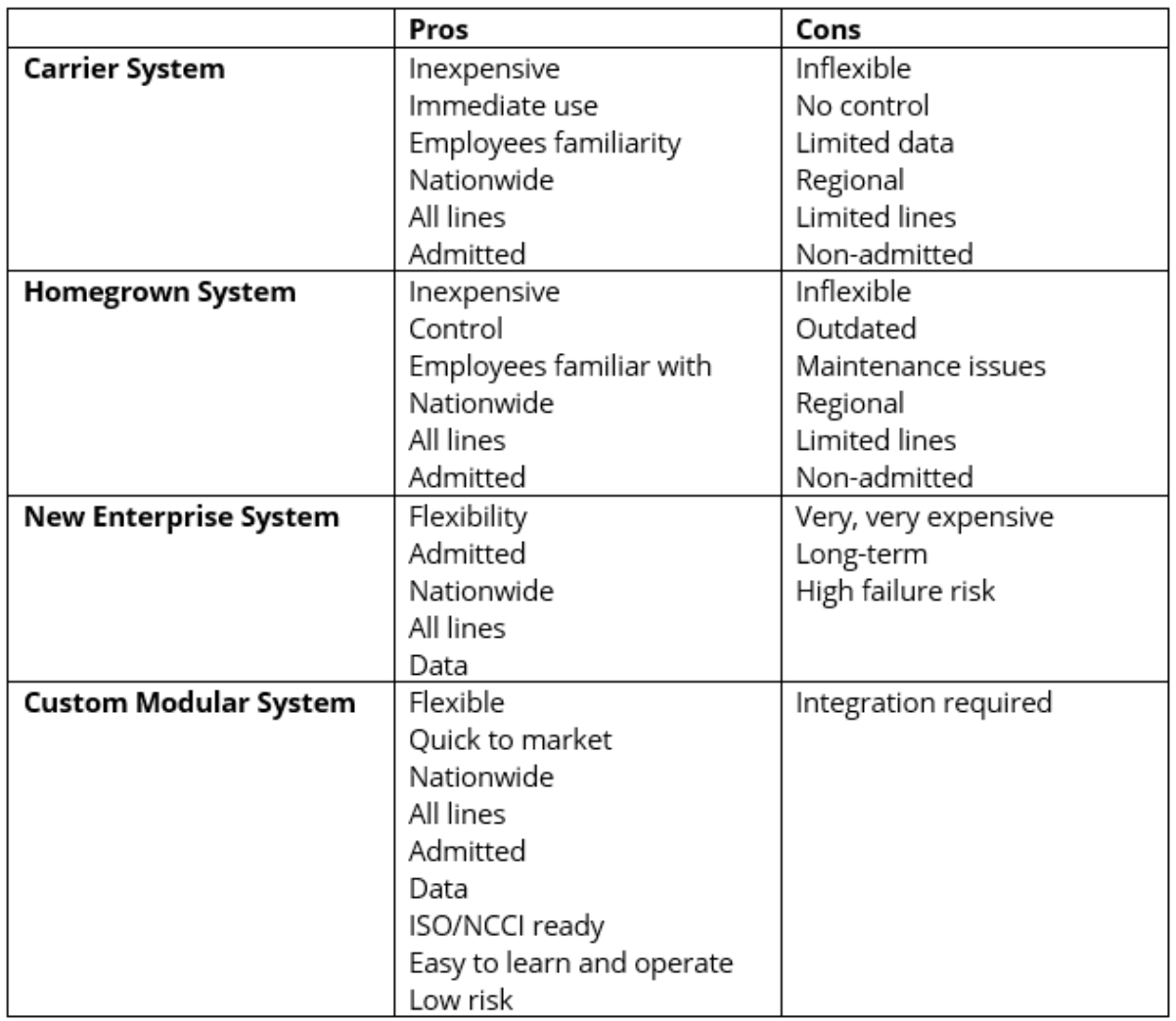This is the latest post in our series on building a new MGA program. The first three steps and an introduction can be found here.
Technology can make or break a program business strategy. As we’ve covered in previous posts, distressed classes only remain distressed for so long until that market need is met. Agencies need a way to bring products to market quickly, or risk losing valuable potential business. Technology is key, but only if you choose your system wisely.
There are four options available when creating a program. You may use the insurance carrier’s system, homegrown software, a new enterprise rollout or a custom modular ISO/NCCI-ready system. Each has its pros and cons. The following is a summary:

As you can tell from the above analysis, the custom modular system is the best fit for programs. Let’s look at the characteristics of a new MGA program and how they match up with this option.
- Most programs today are written on an admitted basis. You therefore need a system that supports bureau content like ISO and NCCI. It should provide the latest rules, rates and forms and regular, accurate bureau content updates to remain in compliance.
- New programs are typically available in all 50 states. You may start off selling regionally, but you’ll need the ability to move quickly into all 50 states when you’re ready to expand. If your system doesn’t give you this flexibility, you’ll end up losing valuable market share in states you can’t enter fast enough.
- It is typical for a program writer to provide one-stop shopping for the industry it targets. Loyal agents prefer this because it is easy to access all that is needed for an account in one spot. So, you need a system that supports all or most business lines, including BOP and worker’s compensation.
- A custom product is key for success in the specialty insurance marketplace. But you shouldn’t need to reinvent the wheel every time you create a program. Typically, 80% of the product can be straight ISO or NCCI and 20% customized. For the 80%, you need an ISO- or NCCI-supported product. For the 20%, you need a system that makes it easy to build customizations, such as endorsements, forms and rating equations.
- Program opportunities don’t last long. If you spot one, chances are one of your competitors has seen it, too. A system that supports programs needs to be implemented quickly – ready to write business in all 50 states in as little as 90 days. A large, enterprise-based system will simply take too long to implement; by the time it’s in production, it may be too late.
- Your program system should also be modular. You should be able to implement or change the functionality you need with no effect on the rest of your programs.
- You also want a system that is easy to understand and quick to learn. Underwriting and rating staff are expensive and hard to find, so you will most likely draw on existing staff for your new program. Your system should have a short learning curve that makes it easy for new users to come up to speed, and your vendor should provide adequate on-site training when you need it.
- Your program solution should easily integrate with other systems and components in your insurance environment, like agency management systems, underwriting workflow solutions and billing. Your technology provider should have proven APIs to make this connectivity seamless, fast and cost-effective.
- Your system should come at a cost that aligns with the scale of your business. You’ve done your homework, but new programs still come with a level of uncertainty. You want a price based on premium volume, not a large, fixed upfront cost.
- Make sure that your technology provider has robust reporting capabilities and that program data is easily accessible. Big data is the name of the game today. The more data you have at your fingertips, the better you can demonstrate to your carrier partner your ability to identify and react to trends in the market.
A final critical characteristic is the need for a well-established tech firm with a superior track record. Your vendor should have adequate resources to deliver what it promises, and a management team that supports a long-term approach to your success.
See also: How Technology Drives a ‘New Normal’
There is a lot to consider when approaching the technology challenges of program business, and picking the right partner can mean the difference between business growth and stagnation. When it comes to program business, technology can deliver a critical competitive advantage.








